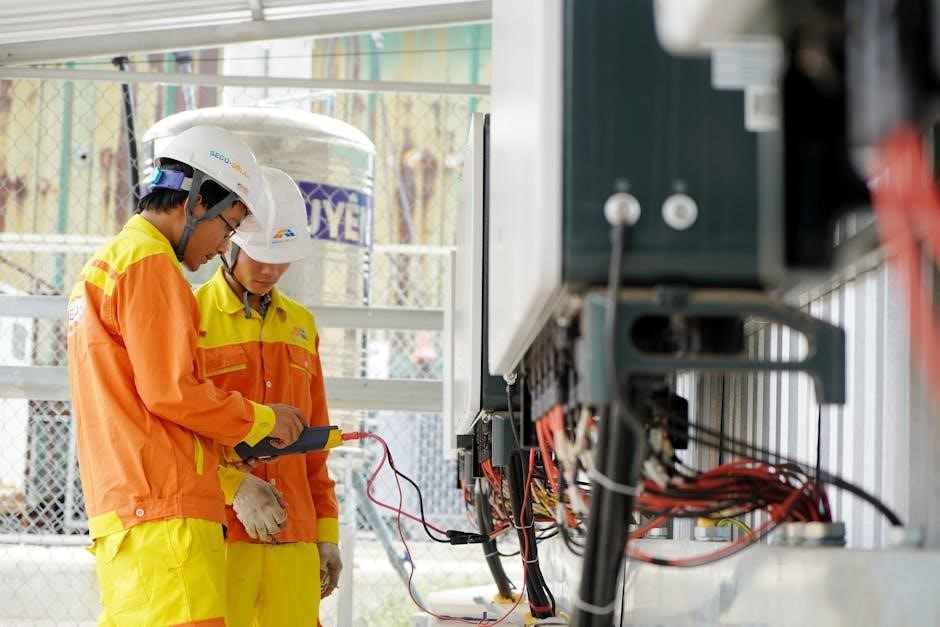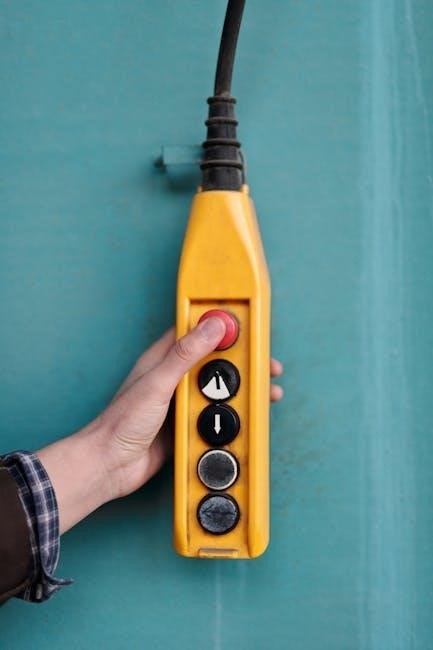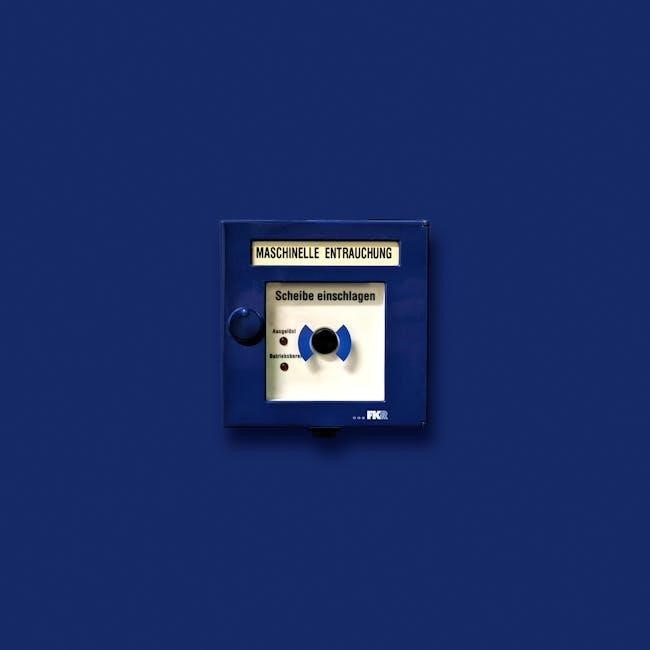Welcome to the Guardian Alarm System Manual, your comprehensive guide to understanding and operating the system. This manual covers installation, operation, and troubleshooting, ensuring optimal security and safety for your property and loved ones. Designed for flexibility and reliability, the system offers advanced features to protect your home or business effectively. By following the instructions, you can maximize the system’s performance and ensure a secure environment. Keep this manual accessible for future reference and safe usage.
Overview of the Guardian Alarm System
The Guardian Alarm System is a comprehensive security solution designed to protect homes and businesses with advanced features and reliability. It integrates seamlessly with fire protection systems, smoke detectors, and emergency exit planning, ensuring a layered defense mechanism. The system includes components like sensor mats, keypads, and silent distress signal activation for enhanced safety. Regular system checks and updates are recommended to maintain optimal performance. This manual provides detailed instructions for installation, operation, and troubleshooting to ensure your Guardian Alarm System operates effectively, safeguarding your property and loved ones with ease and efficiency.
Purpose and Scope of the Manual
This manual is designed to guide users through the installation, operation, and maintenance of the Guardian Alarm System. Its purpose is to ensure users understand how to maximize the system’s features for optimal security. The scope includes detailed instructions for arming/disarming, troubleshooting common issues, and conducting regular system checks. It also covers best practices for maintaining system reliability and integrating with fire protection systems. This manual serves as a comprehensive resource to help users navigate the system’s capabilities and address any challenges effectively, ensuring a secure and safe environment.

System Components and Functions
The Guardian Alarm System includes key components such as sensor mats, keypads, and alarm mechanisms, each designed to ensure reliable security and protection for your property.
Guardian Staff Protection System Components
The Guardian Staff Protection System includes essential components like sensor mats, keypads, and alarm mechanisms. Sensor mats detect movement and trigger alerts, while keypads manage system arming and disarming. The alarm mechanism ensures loud, clear alerts to deter intruders. Additional features such as silent distress signals and central monitoring connectivity enhance security; These components work together to provide reliable protection for staff and property, ensuring a comprehensive security solution. Regular maintenance and testing are recommended to maintain optimal functionality.
sensor mats and Their Installation
Sensor mats are crucial components of the Guardian Alarm System, designed to detect movement and trigger alarms. These mats are typically placed at entry points or strategic locations. Installation involves securing the mat firmly to the floor or surface to ensure accurate detection. Follow the manual’s instructions for proper placement and alignment. Connect the sensor mat to the system’s receiver or control panel using the provided cables. Regularly test the mat to ensure it triggers the alarm correctly. Proper installation and maintenance are essential for reliable performance and accurate detection. Refer to the manual for detailed installation steps and troubleshooting tips.
Keypad and Its Role in System Operation
The keypad is a central component of the Guardian Alarm System, enabling users to arm, disarm, and monitor the system. It allows entry of security codes, activation of silent distress signals, and provides visual feedback on system status through an LCD screen. The keypad also serves as a control interface for configuring settings and reviewing alarm history. Proper use of the keypad ensures effective system operation and enhances security. Refer to the manual for detailed instructions on keypad functions and personalized system settings to maximize protection and convenience.
Alarm Triggering Mechanisms
The Guardian Alarm System utilizes advanced mechanisms to detect potential threats. Sensor mats and motion detectors trigger alarms upon unauthorized activity. The system immediately alerts the Central Monitoring Station, ensuring prompt response. Additionally, silent distress signals can be activated discreetly for emergency situations. These mechanisms ensure comprehensive protection, offering both audible and silent alert options. Regular testing of these features, as outlined in the manual, is essential to maintain reliability and ensure your safety. Understanding and utilizing these mechanisms effectively enhances the overall security of your property and loved ones.

Installation and Setup
The Guardian Alarm System installation involves placing sensor mats, connecting cables, and configuring settings. Follow the manual to ensure proper setup and minimize false alarms.
Step-by-Step Installation Guide
The installation of the Guardian Alarm System is straightforward when following the manual. Begin by placing the control panel in a central location. Next, install sensor mats in high-traffic areas or near entry points. Connect all sensor cables to the control panel, ensuring secure and tidy wiring. Power on the system and test each component to confirm functionality. Finally, configure the system settings, such as security codes and alarm triggers, according to your preferences. Refer to the manual for troubleshooting common issues like false alarms or connectivity problems during setup.
Connecting Sensor Cables and Mats
Begin by placing sensor mats in strategic locations, such as entry points or high-traffic areas. Connect each sensor cable to the control panel, ensuring secure and neat wiring. Follow the manual’s wiring diagram to avoid errors. Once connected, test each mat by triggering it to confirm proper functionality. Secure cables to surfaces to prevent tripping or damage. If issues arise, refer to the troubleshooting section or consult the manual for guidance on resolving connectivity problems. Proper installation ensures reliable performance and accurate alarm triggering. Always test the system after installation to verify all components are functioning correctly.
Configuring the System for Optimal Performance
To ensure your Guardian Alarm System operates at its best, start by adjusting sensor sensitivity to minimize false alarms. Set unique security codes for authorized users and integrate the system with fire protection devices for enhanced safety. Program emergency exit routes and silent distress signals for discreet alerts. Test all functions thoroughly after configuration to confirm proper operation. Regularly update software and firmware to maintain performance. For advanced setups, consider adding radio backup for reliable signal transmission. Always refer to the manual for detailed guidance on customization and troubleshooting specific features.

Arming and Disarming the System
Arm the system using your security code to enable protection. Disarm it with the OFF key or code to silence alarms and clear memories. Ensure proper operation.
Using the OFF Key for Disarming
The OFF key is essential for disarming the Guardian Alarm System. Pressing it deactivates the system, silences alarms, and clears any trouble or alarm memories. To disarm, enter your security code using the keypad and press OFF. This action ensures the system returns to standby mode. The OFF key also sends a silent distress signal if programmed for emergency situations. Always ensure the code is entered correctly to avoid false alarms. Regularly test this function to confirm proper operation and maintain system reliability for your safety and security.
Understanding Security Codes
Security codes are essential for accessing and controlling the Guardian Alarm System. These unique codes ensure only authorized users can arm, disarm, or modify system settings. Codes should be kept confidential to prevent unauthorized access. If a code is compromised, update it immediately through the keypad. The OFF key can also be used to send a silent distress signal during emergencies. Always remember your code, as it is required for disarming and system operation. Regularly updating your security code enhances system security and protects your property effectively.
Silent Distress Signal Activation
The silent distress signal provides a discreet way to alert authorities during emergencies. Activated using the OFF key, it sends a silent alarm to the monitoring station without triggering audible alerts. This feature is crucial in situations where safety is at risk. Ensure your security code is confidential, as it is required for activation. Familiarize yourself with this feature to use it effectively in emergencies. The silent distress signal ensures help is summoned discreetly, maintaining safety and security in critical moments. Always keep your code secure to prevent unauthorized access and ensure reliable system operation.
Monitoring and Notifications
The Guardian system offers 24/7 monitoring, ensuring instant alerts for security breaches. Notifications are sent via SMS, email, or app, providing real-time updates and peace of mind.
Central Monitoring Station Connectivity
The Guardian Alarm System seamlessly connects to a central monitoring station, ensuring 24/7 security oversight. This connectivity allows for real-time communication between your system and the monitoring team. In case of an alarm trigger, the station receives instant alerts, enabling rapid response. The system uses secure communication protocols, such as cellular networks, to maintain reliable connectivity. Additionally, backup options like radio signals ensure uninterrupted monitoring during network outages. This feature provides peace of mind, knowing your property is always protected and monitored, even when you’re not present.
Fire Alarm System Integration
The Guardian Alarm System integrates seamlessly with fire alarm systems, enhancing overall safety and response capabilities; Smoke detectors and heat sensors work in tandem with the alarm system to detect potential fires early. When a fire is detected, the system triggers immediate alerts and notifications, ensuring rapid response. This integration streamlines emergency procedures and ensures all safety protocols are activated. The manual provides detailed guidance on configuring fire alarm integration, ensuring your property is protected from both intrusion and fire hazards. This comprehensive approach helps safeguard lives and property effectively;
Emergency Exit Route Planning
Emergency Exit Route Planning
Emergency exit route planning is crucial for ensuring safe evacuations during alarms or system activations. The Guardian Alarm System manual emphasizes the importance of mapping clear escape paths, free from obstacles and hazards. Proper signage and lighting should be installed to guide occupants to exits. Regular drills and updates to the emergency plan are recommended to adapt to changes in the building layout or occupancy. This section provides detailed guidelines to help users create an effective evacuation strategy, ensuring the safety of everyone on the premises during emergencies.

Troubleshooting Common Issues
Identify and resolve issues promptly by checking sensor connections, verifying power supply, and reviewing recent system changes. Consult the manual for detailed solutions or contact support if problems persist.
Addressing False Alarms
False alarms can be minimized by adjusting sensitivity settings and ensuring proper sensor placement. Regularly test and maintain equipment to prevent malfunctions. Review alarm history to identify recurring triggers and reconfigure sensors if needed. If issues persist, consult the manual or contact Guardian Security for assistance. Proper setup and maintenance are key to reducing false alarms and ensuring reliable system performance. Always follow manufacturer guidelines for optimal results and system reliability over time. This will help maintain a secure and efficient security environment. Regular updates and checks are also recommended to keep the system functioning correctly. By addressing false alarms promptly, you ensure your system remains effective and trustworthy, providing peace of mind without unnecessary disruptions.Keep your system updated and well-maintained to avoid false triggers. Adjusting sensitivity and ensuring proper installation can significantly reduce false alarms. Testing the system regularly helps identify and resolve potential issues early. If you notice recurring false alarms, refer to the troubleshooting section or contact Guardian Security for professional support. Their expertise can help restore your system’s reliability and effectiveness. Additionally, keeping the system software and firmware updated ensures you have the latest features and improvements, further reducing the likelihood of false alarms. By taking proactive steps, you can enjoy a secure and hassle-free experience with your Guardian Alarm System. This approach not only enhances your safety but also optimizes the overall performance of your security setup. Regular maintenance and timely interventions are crucial for maintaining the integrity and functionality of your alarm system. False alarms can be frustrating, but with the right strategies and support, they can be effectively managed and minimized. Guardian Security is committed to providing the tools and resources needed to ensure your system operates smoothly and efficiently.
Resolving System Malfunctions
To resolve system malfunctions, first identify the issue by checking alarm memories and trouble indicators. Ensure all sensors and cables are securely connected and free from damage. Power cycle the system by disconnecting and reconnecting the power source. If the problem persists, consult the troubleshooting section in this manual. For complex issues, contact Guardian Security for professional assistance. Regular system checks and updates can prevent malfunctions. Always follow manufacturer guidelines for repairs and maintenance. This ensures your system operates efficiently and provides reliable protection. Prompt action helps restore functionality and maintains your security.
Testing System Functions
Regularly testing system functions ensures optimal performance and reliability. Start by triggering each sensor to verify alarm responses. Check the keypad for proper arming and disarming. Test silent distress signals and ensure notifications reach the monitoring station. Review alarm memories to confirm accurate event logging. Test fire alarm integration and emergency exit routes for smooth operation. Schedule periodic tests to identify and address potential issues before they escalate. This proactive approach ensures your Guardian Alarm System operates effectively, providing consistent security and peace of mind. Always document test results for future reference and maintenance planning.

Maintenance and Upkeep
Regular system checks, software updates, and sensor cleaning ensure optimal performance. Secure cables to prevent damage and interference, maintaining reliability and effectiveness. Schedule routine maintenance for lasting security.
Scheduled System Maintenance
Regular maintenance is crucial for ensuring the Guardian Alarm System operates efficiently. Schedule checks every 6 months to inspect sensors, cables, and keypads. Update software and firmware promptly to enhance performance. Clean sensor mats and cables to prevent dust buildup, which may cause false alarms. Test all system functions, including alarm triggers and silent distress signals. Address any issues immediately to maintain reliability. Keep the manual accessible for reference during maintenance. A well-maintained system ensures your property and loved ones remain protected and secure at all times.
Updating Software and Firmware
Regular software and firmware updates are essential for maintaining the Guardian Alarm System’s performance and security. Check for updates periodically through the keypad or online portal. Follow the on-screen instructions to download and install updates. Ensure the system is connected to a power source during the process to avoid interruptions; After updating, restart the system and test all functions to confirm proper operation. Updates may include new features, bug fixes, and enhanced security measures. Contact Guardian Security support if you encounter any issues during the update process.
Cleaning and Securing Sensor Cables
Regularly clean and secure sensor cables to ensure optimal performance and prevent damage. Use a soft, dry cloth to wipe away dirt or debris from the cables. Avoid harsh chemicals or abrasive materials that could damage the wiring. Secure cables using cable ties or clips to prevent entanglement or accidental disconnection. Route cables away from high-traffic areas to minimize wear and tear. Check connections periodically to ensure they are tight and free from corrosion. Cleaning and securing sensor cables helps maintain system reliability and reduces the risk of false alarms or malfunctions.

Security Best Practices
Ensure system flexibility and reliability by using radio backup for alarm signals. Keep the manual accessible for quick reference and troubleshooting. Regularly update software for enhanced security.
Ensuring System Flexibility and Reliability
To ensure system flexibility and reliability, utilize radio backup for alarm signals, guaranteeing communication with the Central Monitoring Station even during internet outages. Regularly update software and firmware to maintain optimal performance and security. Test all system functions periodically to identify and address potential issues early. Properly secure and clean sensor cables to prevent damage or interference. By following these practices, you enhance the system’s adaptability and dependability, ensuring it provides consistent protection for your property and loved ones. These measures are essential for maintaining a robust security setup.
Radio Backup for Alarm Signals
Radio backup is a critical feature for ensuring uninterrupted communication between your Guardian Alarm System and the Central Monitoring Station. In the event of an internet outage or primary communication failure, the radio backup system kicks in, maintaining continuous connectivity. This ensures that alarm signals are transmitted reliably, providing an additional layer of security. Radio backup is especially recommended for locations prone to service interruptions. By integrating this feature, you enhance the system’s ability to respond promptly during emergencies, safeguarding your property and loved ones effectively.
Keeping the Manual Accessible
Keeping this manual accessible is essential for understanding and operating your Guardian Alarm System. Store it in a central location, such as near the control panel or in a frequently visited area. This ensures that all users can easily access it when needed. Regularly review the manual to stay informed about system features, troubleshooting, and best practices. Share it with all users to ensure everyone understands the system’s operation. By keeping the manual accessible, you can quickly address any questions or issues, ensuring the system performs optimally and provides reliable protection.

Emergency Procedures
Emergencies require swift action. Ensure emergency exit routes are planned and communicated. Use silent distress signals for discreet help. Regular system testing ensures reliability during crises.
Fire Protection and Smoke Detector Integration
The Guardian Alarm System seamlessly integrates with fire protection systems, including smoke detectors, to enhance safety. In the event of a fire, smoke detectors trigger alarms, ensuring early warning. Emergency exit routes should be planned and communicated to all users. The system’s fire alarm integration ensures comprehensive protection, alerting both occupants and monitoring stations. Refer to the manual for specific instructions on integrating fire protection systems and planning emergency exits. Regular testing of fire alarm integration is crucial for reliability. This feature ensures a coordinated response during emergencies, maximizing safety and minimizing risks.
Understanding Alarm Memories
Alarm memories store historical data of system triggers, providing insights into past events. This feature allows users to review when and why alarms were activated, aiding in identifying patterns or potential issues. Memories include details like the type of alarm and the time of occurrence. To clear alarm memories, use the OFF key, which also silences sounds and disarms the system. Regularly reviewing and clearing memories helps maintain system efficiency and ensures accurate tracking of future events. Refer to the manual for specific instructions on managing alarm memories effectively.
Clearing Alarm and Trouble Sounds
To clear alarm and trouble sounds, press the OFF key on your keypad. This action disarms the system, silences any active alarms or trouble signals, and resets the system to its normal state. Ensure all zones are secure before clearing to avoid masking unresolved issues. If sounds persist, check for additional alarms or system malfunctions. Regularly testing this function ensures smooth operation and quick resolution of false alarms, maintaining a reliable security environment for your property and loved ones. Always verify system status after clearing alarms for optimal safety.

User Responsibilities
Users must test all system functions regularly to ensure proper operation and understand the system’s limitations. Notify Guardian Security of any issues promptly for resolution and support.
Testing All System Functions
Regular testing of all system functions ensures reliability and optimal performance. Users should trigger sensors, check alarm responses, and verify notification systems. Test silent distress signals and ensure all components, including keypads and sensor mats, function correctly. After testing, review the system’s alarm memories to confirm proper operation. If issues arise, refer to troubleshooting guides or contact Guardian Security for support. Testing helps identify and resolve malfunctions early, ensuring your security system remains effective and dependable. Always follow the manual’s instructions for accurate test procedures.
Understanding Limitations of the System
While the Guardian Alarm System offers robust security features, it is essential to recognize its limitations. False alarms can occur due to sensor sensitivity or environmental factors. The system relies on proper installation and maintenance to function effectively; Physical barriers or interference may affect sensor performance. Users must also understand that the system does not guarantee absolute security and should be part of a broader safety strategy. Regular testing and adherence to maintenance routines are crucial to mitigate these limitations and ensure reliable operation.
Notifying Guardian Security of Issues
If you encounter any issues with your Guardian Alarm System, promptly notify Guardian Security to ensure timely resolution; Contact their customer support team via phone, email, or through their official website. Provide detailed information about the problem, including error messages or system behaviors observed. This ensures effective troubleshooting and maintenance. Guardian Security offers 24/7 support to address your concerns, making it crucial to reach out whenever you notice malfunctions or false alarms. Regular communication helps maintain system reliability and your overall security. Always keep their contact information handy for emergencies or technical assistance.

Customer Support and Resources
Guardian Security offers 24/7 customer support. Access video tutorials, user manuals, and FAQs on their website. Contact them at (800) 282-6998 for assistance.
Guardian Security Contact Information
For assistance with your Guardian Alarm System, contact Guardian Security at (800) 282-6998 or (318) 688-4698. Their team is available to address any questions or concerns. Visit their website for additional resources, including video tutorials and user manuals. You can also reach out for support with system installation, troubleshooting, or maintenance. Guardian Security is committed to providing reliable service and ensuring your system operates effectively. Contact them today to learn more about their security solutions and how they can protect your home or business.
Video Tutorials and Manuals
Guardian Security provides comprehensive video tutorials and manuals to help you understand and operate your alarm system effectively. These resources, available on their website, cover topics such as system installation, feature customization, and troubleshooting. Manuals for specific models, like the Honeywell LYNX Touch 5100 and 5200, offer detailed instructions. Video tutorials guide you through setup and daily operations, ensuring you maximize your system’s capabilities. For further assistance, contact Guardian Security at (800) 282-6998. These materials are designed to empower you with the knowledge to use your security system confidently and efficiently.
Frequently Asked Questions
Frequently Asked Questions about the Guardian Alarm System are addressed in this section. Common inquiries include how to disarm the system using the OFF key, understanding silent distress signals, and troubleshooting false alarms. Tips on adjusting system sensitivity for optimal performance are also provided. Additionally, guidance on testing all functions to ensure reliability is included. For further assistance, contact Guardian Security at (800) 282-6998.
Regular system checks and adherence to guidelines ensure optimal performance and safety. Proper maintenance and understanding of the system enhance security and provide peace of mind.
Final Tips for Effective System Use
For optimal performance, regularly test all system functions and ensure software updates are installed. Familiarize yourself with security codes and silent distress signals for emergencies. Always keep the manual accessible and understand system limitations. Properly install and maintain sensor mats and cables to avoid false alarms. Schedule routine maintenance and consider backup systems like radio connectivity for reliability. By following these tips, you can maximize your system’s effectiveness and ensure a safe, secure environment for your home or business.
Importance of Regular System Checks
Regular system checks are crucial to ensure your Guardian Alarm System operates efficiently and reliably. Over time, components like sensor cables and connections may deteriorate, leading to potential failures. By scheduling routine inspections, you can identify and address issues before they escalate. This includes testing alarm triggering mechanisms, verifying security codes, and updating software. Neglecting these checks could result in false alarms or system malfunctions during critical moments. Consistent monitoring ensures your security system remains in optimal condition, providing peace of mind and protecting your property effectively.
